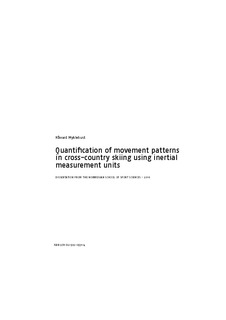Quantification of movement patterns in cross-country skiing using inertial measurement units
Doctoral thesis
Permanent lenke
http://hdl.handle.net/11250/2422117Utgivelsesdato
2016Metadata
Vis full innførselSamlinger
Sammendrag
Inertial measurement units (IMU) are implemented in a variety of commonly-used technological equipment including cars and smartphones. IMUs are sensitive to motion, sample at high frequency, and have become small, wireless, and easy accessible at an affordable price. Hence, IMUs have been introduced as a tool for technique analysis in several sports. The overall aim of this thesis was to assess how, and to what extent, IMUs can contribute to technique analysis in cross-country skiing. Motion data were collected from up to five IMUs, which were mounted on a total of 28 skiers who skied using the V1 and V2 techniques. The most frequently reported technical variable in the literature, cycle time, was among the variables calculated from limb ground-contact temporal patterns. Additionally, three-dimensional hip acceleration, speed, displacement, and rotation were quantified during roller skiing on a treadmill, outdoor roller-skiing on asphalt, and on-snow skiing. This thesis is based on four papers, of which the first two focus on the reproducibility and validity of IMU data during ski skating, while the other two are more applicable to skiers and coaches. Using IMUs allowed for easy data collection, and revealed highly detailed and reproducible movement patterns in all four studies. Limb-mounted IMUs provided a precise and simple way to perform ground-contact temporal analyses, except for estimating the timing of ski plants. For hip movements, the accuracy and precision of measurements (external validity) increased when accelerometer and gyroscope data were combined. Sideways center-of-mass displacement was accurately estimated by hip displacement, but there were large deviations in the vertical and anteroposterior directions. These systematic deviations between hip and center-of-mass movements were caused by arm and upper-body movements, which may be adjusted for. Hip movement patterns captured by IMUs differed systematically between the V1 and V2 subtechniques. V2 showed a similarity to double poling in terms of hip lowering during poling. This allows potential energy gained prior to the poling thrust to be transferred to propulsion through the arms and poles. Further, there were distinct differences between skiers using the same subtechnique, but movement patterns were consistent for individual skiers. IMU data quantified essential V2 technique alterations affecting work economy and performance in elite skiers. Small likely effects on performance were found for both cycle time (more precisely poling time and pure glide time) and vertical acceleration. When directly comparing on-snow skiing and roller skiing, altered hip rotation patterns, greater lateral displacement, longer poling times, and a tendency to smoother hip movements were found for on-snow skiing. The results indicate that different mechanical properties of the skis (not rolling/gliding friction) and/or surface hardness affect the V2 skating technique. Paper I: Myklebust H., Losnegard T., Hallén J. Differences in V1 and V2 ski skating techniques described by accelerometers. Scand J Med Sci Sports 2014: 24: 882–893. Paper II: Myklebust H., Gløersen Ø., Hallén J. Validity of Ski Skating Center-of-Mass Displacement Measured by a Single Inertial Measurement Unit. J Appl Biomech 2015: 31: 492–498. Paper III: Losnegard T., Myklebust H., Ehrhardt A., Hallén J. Kinematical analysis of the V2 ski skating technique: a longitudinal study. Under revision in Journal of Sports Sciences. Paper IV: Myklebust H., Losnegard T., Hallén J. Kinematic differences between treadmill, asphalt, and on-snow ski skating. Submitted.
Denne artikkelen ble tatt ut av den elektroniske versjonen av doktoravhandlingen i Brage på grunn av copyright-restriksjoner.
This paper was removed from the electronic version of this PhD-thesis in Brage due to copyright restrictions.
